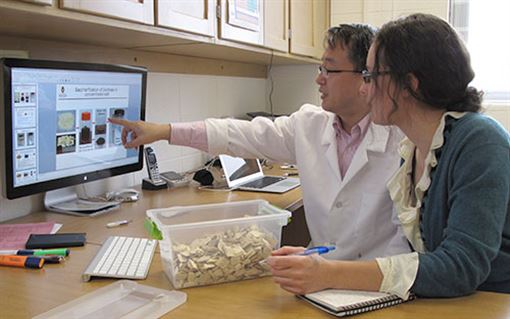New biomass sugar process could be a game changer

A vial of white sugar sits on Xuejun Pan’s desk beside a box of wood chips.
“It’s pretty pure and sweet,” he says, pointing to the sugar. “I’m not encouraging you. But it’s edible.”
With a new method being honed in Pan’s laboratory, the process of transforming tough plant material into powder-soft sugar takes only hours. The reaction is mild, fast and groundbreaking. No harsh pretreatment or enzymes are required. Low costs and sky-high sugar yields – that may exceed 90 percent – make Pan’s method one of the best in the business.
Standing in his lab in the Enzyme Institute, Pan swirls a test tube of syrupy extract. A murky layer of lignin settles at the bottom.
“Think about the future when we run out of oil. We may have solar energy, wind energy, nuclear energy and hydro. But what about the chemicals and materials currently derived from petroleum? Biomass likely is going to be the only option. Biomass-derived sugar will be the hard currency of the future bioeconomy.”
The work going on here is exciting because it has been speculated that biomass holds the potential to yield 1 billion tons of sugar per year in the U.S., equivalent to 80-150 billion gallons of ethanol. However, current methods to produce bioethanol from cornstarch or sugarcane are inadequate and unsustainable to meet the global demand for renewable fuels.
To be sustainable, biofuel production should instead rely on abundant, inedible lignocellulose like switchgrass, corn stover, wheat straw, wood chips and waste paper.
The problem, Pan explains, is that lignocellulose is a complex material made of cellulose wrapped in tough hemicellulose and lignin. For this reason, lignocellulose is more difficult than starch to break down and convert (hydrolyze) into fermentable sugars. Harsh acids, blazing heat and other pre¬treatments traditionally have been required before introducing pricey enzymes.
Needed is a cost-effective, single-step approach to extract the sugar.
“We’re reducing process time from days to hours,” Pan says.
“At the very beginning when we were presenting, there were doubts. Could it really be true?”
Key to his approach is the use of inorganic bromine salt (lithium bromide or calcium bromide) to break down lignocellulose and unleash fermentable sugars. Other labs have investigated other salts, but poor performance and byproducts dog the results.
Pan’s reaction method works on raw biomass at stovetop temperatures, hydrolyzing cellulose and hemicellulose and releasing monosaccharides for subsequent biofuel or chemical production. Lignin separates from the product sugars and can be filtered out for use in coproducts. The bromine salt can be recovered and reused.
“Success of this technology could be game changing,” Pan says. “If you can get easy, low-cost sugar, you’ll be a winner in the game.”
Support from the Accelerator Program is now being used to scale up the process to the point that it will be practical for industry. Demonstrating that the salts can be cheaply separated and recycled will be crucial.
Pan says that guidance from Accelerator Catalysts has helped him make technical modifications as well as polish an entirely new skill.
“I don’t have experience in marketing technology,” he says. “Catalysts helped me understand what industry is interested in.”
With several patents under his belt, Pan’s biomass conversion methods are part of WARF’s Clean Technology portfolio.